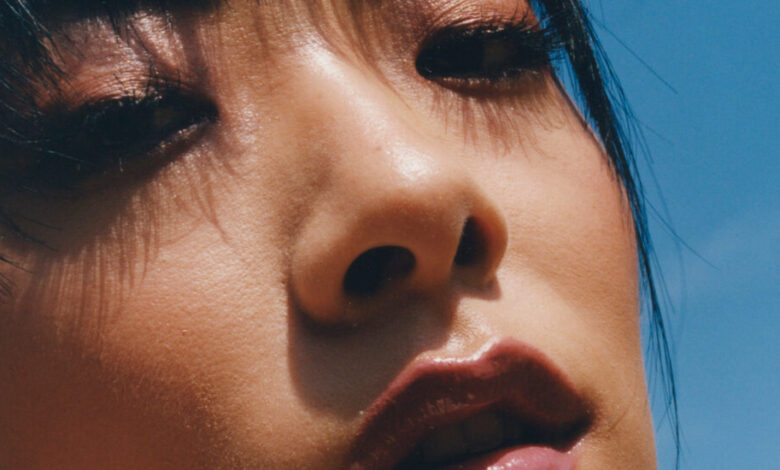If It’s All Going to Hell, Rina Sawayama Can’t Wait to See You There

On a sticky June afternoon at the Balloon Saloon, a party store in Tribeca, a casual shopper would have found an array of stick-on piercings, a host of glow-in-the-dark finger puppets, a shocking selection of fake excrement and one pop star giggling about it all.
Rina Sawayama wandered through the aisles squeaking with equal parts delight and mild horror, posing for pictures with mannequins before settling on two flags: a rainbow one, in honor of Pride Month, and, seeing as it was one of the British-Japanese artist’s last days in the United States for a while, a Stars and Stripes.
It was the final week of a pandemic-delayed tour supporting her 2020 debut, “Sawayama,” and she was feeling emotional. “I’m going to miss stories with the fans and just sharing that incredible energy in the space,” she said a few hours earlier, over lunch. “It’s almost like a relationship.”
Her shows at Brooklyn Steel in May showed off the depth of that bond, as well as the breadth of Sawayama’s musical palate: part rock concert, part pop spectacular, part group therapy session for a mostly young, mostly queer crowd. As the bass throbbed and heads bobbed, Sawayama commanded the stage, singing, swearing and offering words of affirmation and appreciation: “Thank you for making me feel seen, and thank you for making me feel heard,” she announced; later, she instructed audience members to tell each other they’re hot.
Sawayama, 32, has muscled her way to pop stardom as a devoted student of it, building an aesthetic out of the parts she likes — Lizzo’s empowerment, Charli XCX’s fun-and-freakiness, Lady Gaga’s genre-clashing vastness — and tossing aside the rest. (Her studiousness isn’t limited to music: She graduated from the University of Cambridge with a degree in politics, psychology and sociology.)
“Sawayama,” an unexpected mix of head-thrashing rock and early aughts bubble-gum pop, arrived after seven years of making (and largely funding) her own music. Its April 2020 release date was not fortuitous. Now the singer and songwriter is trying to regain the momentum lost when the pandemic swallowed her debut and turn it up to 10 for her second album, “Hold the Girl,” due Sept. 16.
“A lot of times, artists feel the pressure to do sessions and just bash out songs, but I am just not like that,” Sawayama said earlier this year during the first of two long interviews. “I don’t like working hard, I like working intentionally.”
Sawayama knew she needed to pivot. So much had changed, in big and small ways, since her first album: The world was tense and dangerous; she’d turned 30 and entered a new era of personal evolution, starting an intensive form of therapy and folding its revelations into the DNA of “Hold the Girl.” She won’t reveal those realizations just yet, in part out of fear that she’ll influence her fans’ responses to the songs.
“I think the temptation, as an artist these days, is to look online and see what the fans want,” she said. “But I’m going to write something that’s meaningful and worth people’s time.”
The result is an expansive album that stuffs in even more of her musical inspirations, with nods to everyone from Shania Twain and Abba (on “This Hell,” a cheeky, country-flecked song that sounds like when a church group facilitator accidentally makes purgatory sound really fun) to Gwen Stefani (she wanted the floaty “Catch Me in the Air” to resemble the Corrs writing a song for the frontwoman turned pop star) to Madonna (the sparse, echoey introduction to the single “Hold the Girl” feels related to “Like a Prayer”).
Combining nostalgic sounds with the latest technology allows Sawayama to experience the best of both sonic worlds. “What I think about the New Jack Swing era, and production from the ’90s in general, it’s like …” she groaned. “The sound was so ambitious, but I think just the tech of that time didn’t capture the full breadth of it.”
Clarence Clarity, the primary producer on both of Sawayama’s albums, described his process of making music with Sawayama as throwing a bunch of disparate eras and aesthetics together and seeing what works. “It doesn’t really matter what genre it is from song to song — it’s how can we evoke these different feelings,” he said in an interview.
“That’s the nice thing about working with Rina,” he added. “She doesn’t think in traditional terms.”
WHEN WE MET up in February in the back of a verdant hotel lobby, our worlds finally thawing from the double-punch of a pandemic winter, Sawayama wore her long black hair straight down to her shoulders, her brutally cut asymmetrical side bangs emphasizing her angular face. Though onstage she favors dramatic, sculptural costumes, that day she resembled a ballerina out on a bodega run in a black hoodie and sweatpants. Looking at her hands felt like peering into a silverware drawer: a silver or green ring on nearly every finger, her nails painted chrome and covered in baubles and pearls in the same shade, like gilded sweat. She had only gotten them recently, and they were a lot to get used to.
“I don’t know how Rosalía does it,” she said.
I asked Sawayama about the last really good party she’d been to. Her answer sounded like a civilian’s fever dream, various celebrities brought together by nothing but vibes, or the sort of party you imagine happens once you make it. She ended up doing karaoke with Harry Styles, Karamo Brown and Bobby Berk of “Queer Eye” fame, the model Kiko Mizuhara and a stylist friend.
That night was four years ago. “Have I been to a party since?” she wondered aloud. It’s unlikely. Even in her early 30s, Sawayama is a retired socialite, having gotten it all out of her system when she was in her teens. She was born in Niigata, Japan, and temporarily moved to London as a young child with her parents. They soon divorced, which changed not only her home base — she ended up staying in London — but also her family’s class status. The singer shared a bedroom with her mother until she was about 15; the combination of that claustrophobic proximity, adolescence and the language barrier — neither spoke much English — all weighed on her, coalescing into a new identity that Sawayama could form for herself: a pop music fanatic.
She used the genre to connect with her classmates, forming close friendships that took her out of her home and into a much wider world. As an early teen, she’d listen to albums at the Virgin Megastore for hours — the Killers, Bloc Party — then shadow those bands from gig to gig. Once, she followed a group she liked to Paris on her own, bunking with a fellow fan she’d met at a show. At 16, she started uploading her own music to the internet — covers of her favorite songs.
“I was very angry as a teenager, and me going out was a reaction to that,” she said. (When I asked what “going out” looked like, Sawayama said that people were basically pretending they were on “Skins,” a British TV show akin to “Euphoria” that was airing around this time.) “I really think I had to find my creative voice later on in life because I didn’t have that time on my own,” she said. “I didn’t have any space. I didn’t have any privacy. I was worried about even writing my diary.”

Starting her career in music a bit later in life, “I’m able to come to the table with a bit more stories, say and life experience and things to write about,” Sawayama said.Credit…Olivia Lifungula for The New York Times
At the ripe age of 15, Sawayama walked into her kitchen one morning and announced she was done having puberty. (Her mother was not easily convinced.) But she had gotten all of her partying out of her system, and just in time, too: She recommitted to her grades and ended up enrolling at Cambridge. The culture shock hit hard: Sawayama spent most of her program depressed, and her relationship with her mother continue to sour until she got kicked out of the house.
Sawayama worked various jobs — as a model, at an Apple Store (until she got fired for modeling in a Samsung advertisement), in an ice cream truck, as a nail tech. On the side, she developed her music, uploading new recordings to SoundCloud in between shifts. Eventually, she started getting recognized while doing pedicures, so she gave that gig up.
Her manager introduced her to Clarity, the producer, and they collaborated on “Rina,” an EP released in 2017 about digital and cultural anxieties. Sawayama played small tours at home and the United States, but needed to keep working various jobs to support herself in between shows.
“I signed my first record deal when I was 29,” she said during our second interview in May, over French fries at the Odeon in Tribeca. “Which is just so late for a pop artist, and I love that I’m able to change that in a positive way. I’m able to come to the table with a bit more stories, say, and life experience and things to write about.”
Maturity has other benefits, too: In between Sawayama’s albums, some of the artists she’d admired became collaborators. She remade her own song “Chosen Family” with Elton John, teamed with Charli XCX on the pop star’s single “Beg for You” and provided vocals on a remix of Lady Gaga’s “Chromatica” track “Free Woman.”
Her reach still shocks her. “All those people I grew up listening to” — she said she’d also heard her fans include Katy Perry and the producer Jack Antonoff — “I can’t believe they know I exist,” she said.
But Clarity, who noted that Sawayama’s new album is far more personal than her debut, isn’t surprised: “She was meant to be a pop star,” he said. “She was born to do this.”
FOR YEARS, SAWAYAMA has kept a list of interesting quotes or phrases in a Notes app on her iPhone as potential sources for inspiration, lines from books or from conversations with friends. The title of one of her new singles, “This Hell,” sprung from that list: Though she had originally clacked out “this heaven is better with you,” the phrase had morphed by the time she got into the studio, where she realized hell could encompass more of her reality.
For one, parts of the pandemic were certainly hellish. For another, restrictive religious beliefs are being codified into law across the world. Like Lil Nas X, another artist who responds with queer insouciance toward Judeo-Christian homophobia, the song’s lines — “God hates us? All right then!/Buckle up, at dawn we’re riding” — imply that there’ll be plenty of good company on the road to perdition.
“I was just like, ‘If there is a belief that we’re wrong for wanting to have autonomy in our bodies or identities, then [expletive] it, we’re all going to go to hell, and let’s have a party,” Sawayama said, laughing and adding a few additional expletives. She identifies as pansexual; the music video for the song features the singer in a three-way marriage with a man and a woman. “Hell is going to be the place to be, evidently.”
Onstage in Brooklyn in May, Sawayama brought her fans into her version of it — devil chic — vamping about the stage in a blood-red, strong-shouldered unitard. Lithe but powerful, she twisted and snaked her upper body with aplomb, adding extra flicks of rhythm when she felt the call to. At one point, her guitarist came forward to join her at the front of the stage, shredding powerfully, losing herself as if in a trance. But Sawayama only had eyes for the instrument itself, her eyes locked onto its strings, dancing in response to its sounds, almost like she had been possessed.





